by scott.gillum | Sep 7, 2012 | 2012
The 2012 Presidential election will be the most expensive in history. According to the New York Times the candidates will raise and spend over $1 billion dollars seeking office. For marketers, this election will yield a windfall of new ideas. Political campaigns are to marketing innovation what big defense budgets are to technology innovation.

2012 Campaign Spend
As the result of massive advertising budgets, high adoption rates of social media and penetration of smartphones, expect to see groundbreaking innovation in mobile advertising.
Areas to watch:
- Hyper-local targeting – the Obama campaign team has developed an app that links a Google map to the neighborhood volunteers are working. The map contains blue flags at homes to be knocked, including scripts for approaching individual voters.
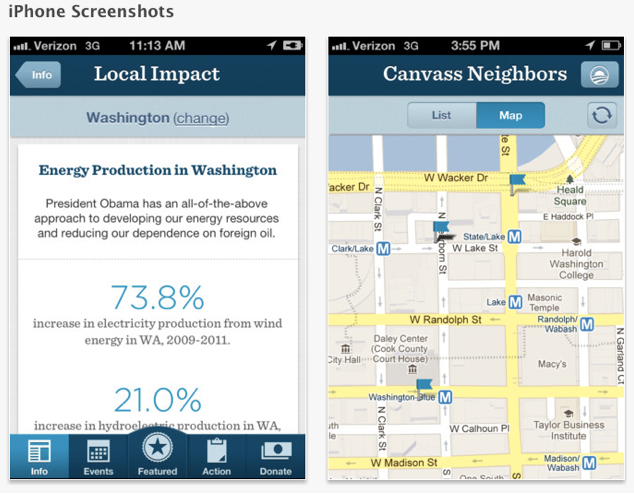
- Mobile geo targeting – during a concert in Grant Park in Chicago the Romney team placed display ads on smartphones of those concertgoers and others in the vicinity. In TIME magazine recent The Wireless Edition, Patrick Ruffani, the Republican digital consultant said; “We weren’t paying for the entire city.”
- Mobile payments – the Obama team developed a new program called “Quick Donate.” Supporters can contribute repeat donations by sending the number of dollars they want to donate via a text message.
- Social Sharing – Romney’s With Mitt app allows supports to choose from a number of “With Mitt” templates to upload a photo from their phones and quickly share it on Twitter or Facebook.
- Real time data – both camps have apps to enable volunteers to report real time activities and interactions with voters. Vote Builder, the democratic voter database, ensures that no two people are sent to the same address. If a volunteer wants to canvass an area, they can click to download a list of households in their general radius. Phones prompt volunteers to report back their results so that future campaign communications, like DM, can be targeted.
- Engagement – Romney’s campaign team captured valuable information from supporters who downloaded the Mitt’s VP app. The app promised to inform supporters “first” about the vice president pick. Unfortunately, the news media beat them to it, but it will allow Romney’s team to push notifications throughout the campaign to supporter’s smartphones.
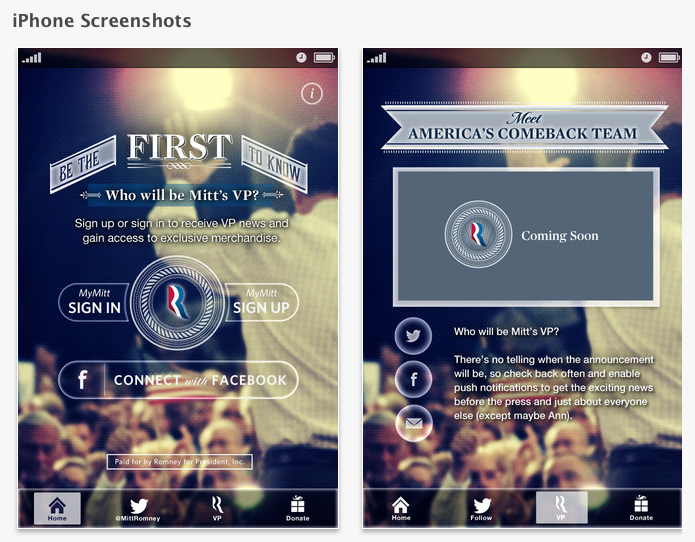
With less than 10 weeks remaining in a tightly contested election expect more innovations to come. With over 160 million Americans on Facebook and 53% of mobile phone owners having smartphones today, mobile digital campaigning is changing the way political strategists are engaging audiences and investing advertising dollars.
For marketers, it’s mobile marketing R&D that we could never afford, and will bear fruit for new ideas and campaigns for years to come. Regardless of who wins the election, the real winners from this year’s campaign will be the folks without the billion dollar-marketing budget.
by scott.gillum | Aug 20, 2012 | 2012, Marketing
Everybody knows – or thinks they know intuitively – that social elements add value to marketing. The question is how?
Like anything in business, it comes down to return on investment. Social media is not a strategy and it’s not an end in itself. Unless your business objective (and I’d check with your shareholders on this) is only about gaining page views and follows, marketers need to understand how social adds value to everything else in your toolkit.
So how do you find the “sweetspot” for developing an ROI for social media? Well, start by viewing the tools at their most basic level, as vehicles for sharing and; photo’s, thoughts, content, etc. Consider them “levers” for improving the performance of known activities that have produced a ROI.
Five years ago, we assessed the effectiveness of demand generation campaigns for a client. Because the firm was in the hi-tech industry they had a heavily reliance on content marketing for their campaigns. They spent months designing and building them, and hundreds of thousands of dollars in execution only to see diminishing results.
The audit revealed that their campaign effectiveness (related to lead production) lasted roughly 36 hours after launch (see below). Meaning that the majority of the leads were being created within the first three days of launch, regardless of how long they left the campaign in the market (btw – they are not alone).
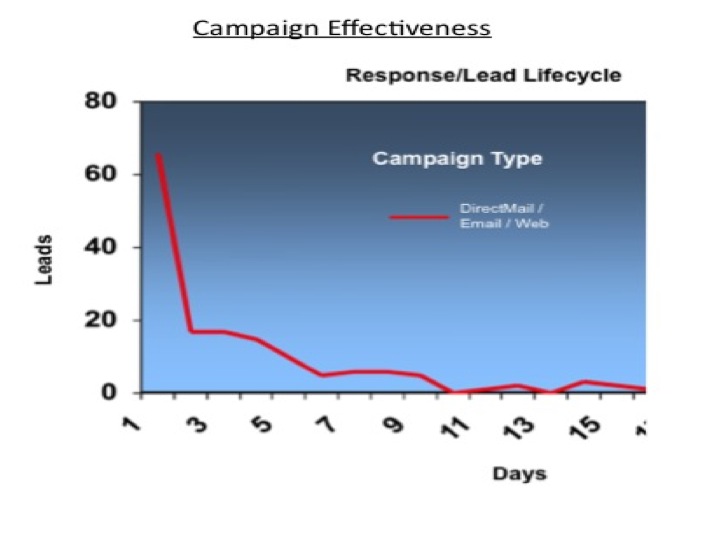
Today, social media has the potential to create a long tail, extending the life of expensive campaigns, ultimately improving ROI, and along the way creating and deepening the relationship with the audience.
I’ll use myself as an example: A blog post of entitled The End of Blogs (and Websites) as We Know Them ran recently in on Forbes. It received no special promotion; in fact, you could say the deck was stacked against it. Posted on a Friday, the slowest traffic day of the workweek, at midnight (EST) when most of the blog readers at home or are in bed. By prime blog viewing time (10 am) it had almost dipped below the fold.
But on the following Monday it took off, almost doubling the views of Friday, and continued to build momentum ending the week as the 3rd most popular post of the day. The following week it was the most popular post on Wednesday. So what happened?
Social took over. Without any additional investment to promote the post, social sharing accelerated and extended the life of the post, even as it fell off the first, second and third page of the site. Readers engaged and went from passive viewers to active promoters.
Readers were tweeting their own thoughts and comments about their insights, not just retweeting the post title. They placed in into Linkedin groups adding their comments on the impact of the technology (the topic of the post) to their particular area of interest or role. They were actively engaging in sharing their “discover” with others.
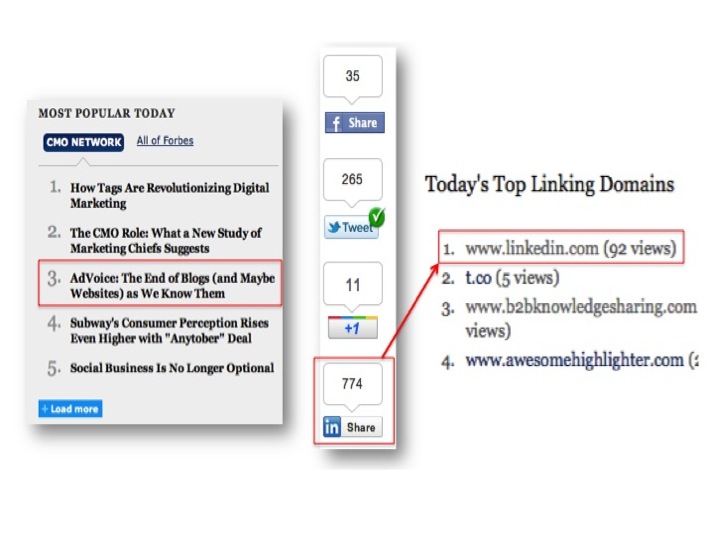 That is the power and the value of social media for content marketing.
That is the power and the value of social media for content marketing.
The post no longer needed to be pushed because it was being endorsed, and in some ways validated, by readers — the most trusted source of information.
The potential of social media is intriguing, but to determine its true value companies will need to experiment. Using social media to support your content marketing efforts is a prudent choice, but keep this in mind: It will only be effective if the audience/community finds value in the content and part of that value is defined by those who pass it along.
by scott.gillum | Aug 13, 2012 | 2012, Observations
Big data is about to get bigger. Deliotte predicts that by the end of 2012 more than 90 percent of the Fortune 500 will likely have at least some Big Data initiatives under way. Companies will likely spend $1-1.5 billion to enable their organization to collect, analysis and use “big data” with the intent of gaining a better understanding their customers. But according to Doc Searls author of the new book Intention Economy: When Customers Take Charge that may be a waste of money.
Searls points out in a recent article in the Wall Street Journal, that as fast as companies are configuring systems to capture data at customer touchpoints, consumers are disabling collection sites. In May of this year, ClarityRay reported that the overall rate of ad blocking in the U.S. was 9.26%, and even higher on certain types of site and browser (download the report on ClarityRay’s website).
In May, Microsoft announced that the “Do Not Track” (DNT) feature will be turned on by default in the next version of Internet Explorer. Add this to Dish’s ad skipping product, Hopper and you have an increasingly less assessable consumer. What does this mean, well according to Searls it’s leading to a point where the supply side will yield influence, and ultimately power to the demand side, the consumer.
Searls book explores how customers will transact over the next 10 years, and the rise of Vendor Relationship Management (VRM), think CRM built for consumers to aggregate personal information and signal their intention to vendors on their preference, terms and desired price. As Searls points out, sites like Priceline and Travelocity, have started this movement but they are still “siloed.”
The tipping point for the next wave is fully empowered consumer, untethered by restrictive contracts, and siloed information. In this new world, consumers will have software that can integrate apps with the services offered by companies, saving time for consumers and creating commerce for companies in real time.
Imagine a business trip in which your phone apps for travel, budgeting, mapping, all work together to compare offers, make reservations, and filling out expense reports along the way.
What will it take to enable this revolution? Ultimately, it comes down to the recognition that a free customer is more valuable than captive one. Companies who will thrive will identify opportunities that take advantage of consumer’s freedom that they have, or want. A mindshift from thinking of consumers as “targets” that live in “populations” who need to be “acquired” or “locked in.” To an empowered individual buyer who will signal their intent to a company, as long as there is a trusted relationship.
In this personal empowerment revolution outlined by Searls, the future of buying lies not in investing in big data systems to figure out consumers, but rather by integrating apps that enable “small data” to be used by consumers.
Big changes for big data are looming on the horizon…
by scott.gillum | Aug 10, 2012 | 2012, Marketing
In 2004, I was part of research project with a professor at the Kellogg School of Management and the CMO Council that sought to understand what CMO’s believed to be critical for their success. The most common response was a seat at the table with other senior executives.
Four years ago, I was part of another research effort focused on the CMO’s top priorities, and number one on the list was to be viewed by their peers as strategic thinkers. Finally, I believe the day has come for that to happen.
Marty Homlish, the CMO of HP believes the line between business and consumer marketing is disappearing. Homlish states, “ Behind every B-to-B company is a consumer. The way you communicate to that person is as an informed consumer.”
Technology has allowed work to follow us home and our home life to the office. It has blurred the line between our personal and business personas. The concept of being ‘at work’ is now more a state of mind rather than a physical location or particular time of day.
If business buyers – who were once thought of only as rational decision makers – now need to be communicated with as informed and emotional consumers who no longer fit our past perception of work hours and locations, what might this mean for the future of business-to-business marketing?
To answer that question, one must first understand the difference between how business and consumer marketing operate. According to a Booz & Co and the ANA in The New B2B Marketing Imperative study, B2B marketing has primarily taken an “inside out” approach, focused on the needs of the company and accounts rather than customers.
By contrast, 85% of B2C marketers, who take an “outside in” approach said they were involved in growth initiative decisions which are considered to be strategic such as new market entry, customer relationships and market driven product development.
Additionally, 42% of B2C marketers play a key role in building customer relationships, versus 8% of business marketers. B2B marketers said that “Customers are rarely driving the process and their input is seldom integrated from end to end.”
If today’s business buyers really are “educated consumers” as Homlish suggests, then business marketers can no longer be left out of customer and product conversations. It also means that organizations that target business buyers, who has given lip service to transitioning from being “product led” (inside out) to “customer focused” (outside in) now need to act. And the tip of the spear for driving that change – is marketing.
By better understanding and influencing the needs, desires and emotional drivers of individual business consumers, marketers will be in the strategic conversation and lead the transition. This is the key to unlocking the executive suite.
However, the organization is not just going to give marketers a seat at the table and there is a good possibility that executives don’t get it. As one of the marketing directors said in the study; “Marketing is just not in the DNA of senior management.” You will have to make it happen.
The study concludes that; “Core marketing capabilities – those that directly influence customers – have the highest correlation to market share growth.” Senior executives may not understand marketing but they do understand growth.
by scott.gillum | Jul 19, 2012 | 2012
This post appears today on MediaPost’s Online Media Daily
Fancy (www.thefancy.com) is being totted as the next “Pinterest.” Now having passed a million members, its becoming the social media darling of the digital media. Add to that an all-star cast of investors, a defined business model based on commerce and you’ve months of hype to come.
What It Is
It combines the transaction capabilities of a daily deal site, like Groupon, with the visual imagery and organization of Pinterest. Like Pinterest, The Fancy lets users curate and organize images into list or boards. Unlike Pinterest, users can shop and with a click buy the product at on a third party site. It’s built with the intent of driving commerce. The Fancy, like daily deal sites, pushes out a daily email of specials to members.

Pinterest member commenting on a new flash drive
What’s Cool About It
Unlike other social media platforms (Pinterest, Twitter, Facebook, etc.) who first built a member/user base, Fancy is placing a bet on a defined revenue model out of the gate. And that bet is commerce, not advertising, at least not yet. As it is today, the Fancy will get 10 percent of each sale, paid for by merchants.

The Flash Drive, mentioned by the Pinterest member, on sale on The Fancy site.
But the real attention getter is the bet it’s placing on the power of social networks on purchase decision. The “holy grail” for social sites, is the ability to show a direct correlation between brand preference and buying that brand. Fancy, because of the integration of commerce and an ability to track conversion, has the potential to link intent with purchase. If successful, Fancy will attract merchants (and eventually advertisers) like a moth to a flame.
Three Reasons It May Not Work
Although I love the concept, there are several potential risks that could derail its success:
- Boxed in – The Fancy, unlike others, is trying to build a community around a business model. It’s a high risk gamble because, as other have seen (Linkedin and MySpace for example), business models often evolve based on users behaviors, which is often hard to predict. The other question – is Fancy entering a market that appears to be on a downward trend or could it be the next generation of daily deal sites?
- False Positives– It’s unclear how users will respond to unsolicited recommendations. The hope is that followers of users who had post products will self identify and make their intent known. The risk here is triggering “false positives,” in that, users my signal intent (“Fancy It”) without having any real motivation or desire to make a purchase decision. Yes, I want to buy the Ferrari you posted, but the reality is that’s not going to happen.
- Too Cool – one thing is certain about Fancy, members curate eye-catching products (carbon fiber beach paddles by Channel, for example). As Tim Peterson of Adweek points out, “Fancy is most useful to trendsetters and tastemakers, particularly those with disposable income.” But are the products being aggregated too cool for commerce? To scale the business will Fancy have to aim lower to drive transaction volumes?
Today, Pinterest’s conversion rate is now 3x that of Facebook (1.1% versus .35%). The big question is will that rate go higher with the integration of a commerce engine, like Fancy? If so, Pinners just might fancy a transaction on another platform…and merchants and advertisers will be right behind them.
by scott.gillum | Jul 19, 2012 | 2012, Sales
Large companies have long recognized the opportunity to address the needs of small business (26 million firms <99 FTE’s). Over the years, companies like IBM, American Express and Google have spent millions to try to understand the segment and convince business owners that they have the products and services they need.
Yet, they still struggle to capture of the opportunity in this segment, for a number of reasons. Despite their best efforts, they often fall back into their “big company” ways. They speak the wrong language, have a hard time creating compelling offers, and/or reinforce perception that they’re too big to serve small businesses.
Whether you’re a Fortune 500 company or an INC 500 firm, here are 10 key points to keep in mind when selling to the Small Business segment. All Insights below are taken from various research reports produced by the Executive Council on Small Business.
1. Don’t call them Small Businesses – despite this becoming common knowledge for many selling to this segment, companies still make the mistake. Despite the fact that 60% of small businesses, as defined by the U.S Census Bureau 2008, have less than 5 employees, don’t call them a small business.
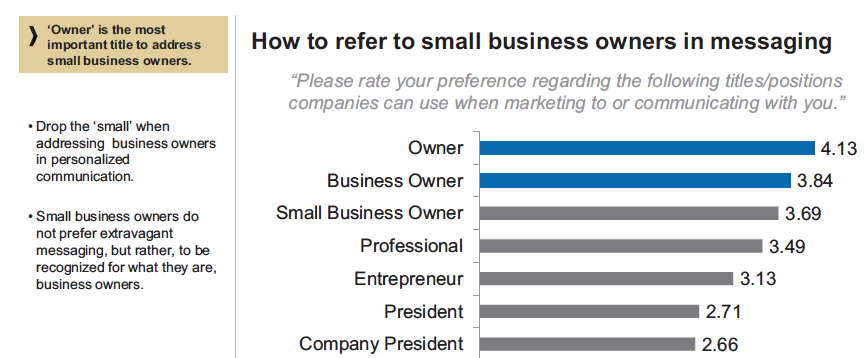
2. There are 2 different types of business owners – one type of owner is focused on growing their business, the other surprisingly, is not. Know the difference when targeting this segment. “Satisfaction owners” know also as “lifestyle owners” are older (>46) and more likely to have higher revenue businesses. They are in it because they love what they do and enjoy the work-life balance ownership present. “Growth” owners are more likely to be in retail, and more likely to have owned or own more than one business (serial entrepreneurs).
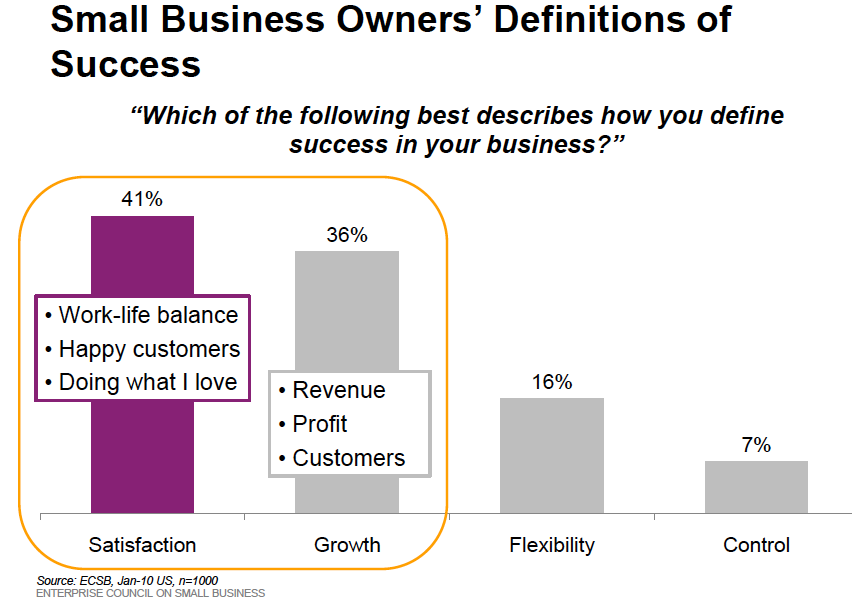
3. They are in the Service Business – for the most part small businesses are focused on providing services. 60% of small business are; professional services or other services (dry-cleaning, florist, cleaning service, etc.).
4. Speak THEIR language – As you might have already picked up, this will be a reoccurring theme in the post. 3X as many business owners find a sales person more trustworthy if he/she discusses savings in dollars rather than percentages. To be credible give them specific details, contact information and testimonials for other business owners (Top 3 Indicators of Credibility).
5. Small things are a BIG Deal – according to the research, a major purchase decision starts at $500. Cash flow is the lifeblood of small business don’t under estimate your need to prove value or ROI on what you would consider small transactions. If you’re talking about cost savings, express it in monthly terms rather than annual. 2X as many owners expressed seeing savings monthly rather than yearly.
6. Resources and Time are Tight – owners now make a purchase decision in less than a week for complex and simple products. 43% said that it now takes them less time to make a decision than it did 5 years ago. They search online, visit your website, and then call to confirm what they’ve learned. SEO is critical if you’re going to play in this segment, as you will see below.
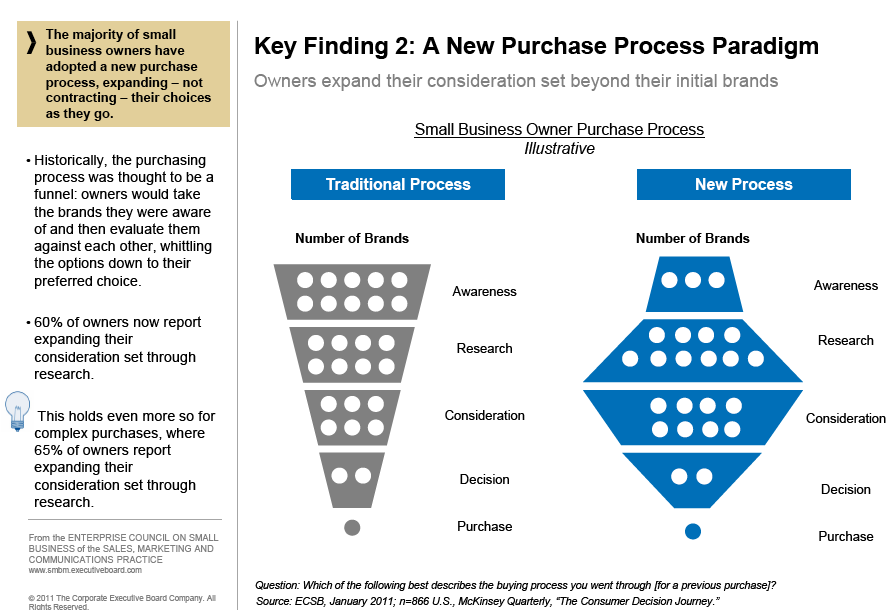
7. They Love to Search – Business owners purchase patterns have changed, instead of contracting it’s now expanding. Rather than narrowing their list of vendors, 60% of owners now report expanding their consideration set through research.
8. And it’s Local – business owners search for a product or services by name, not a brand, and they include their local area (e.g. “internet providers in St Louis”). They don’t include “small business.”
9. Search is Important, but Social Isn’t – as you saw in the previous examples Search is critical for being considered, but interesting enough, Social Media is not. The reason – small business owners view social media as a channel to speak about their businesses, rather than hear what suppliers have to say.
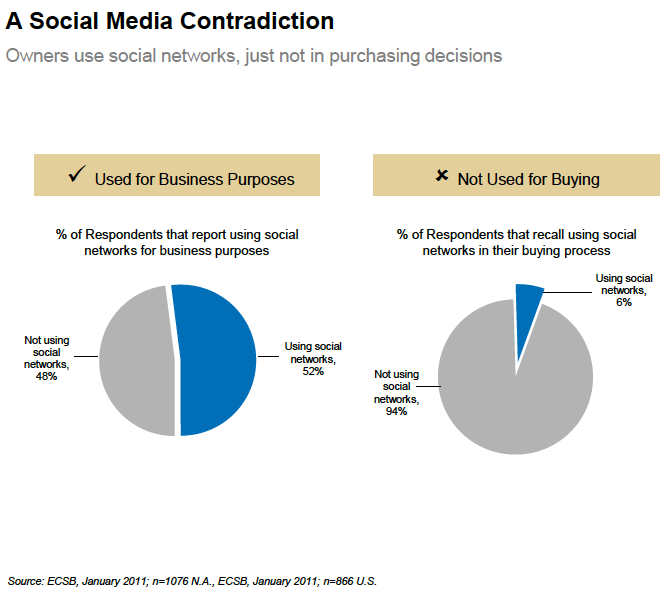
10. If You’re Not Relevant…You’re Not Relevant. In today’s marketplace to resonate with audience content must be personalized. A recent Forrester report showed that most sales forces very capable of discussing products and solution, and even the industry issues, but when it came down understanding the buyer’s role or situation they failed.
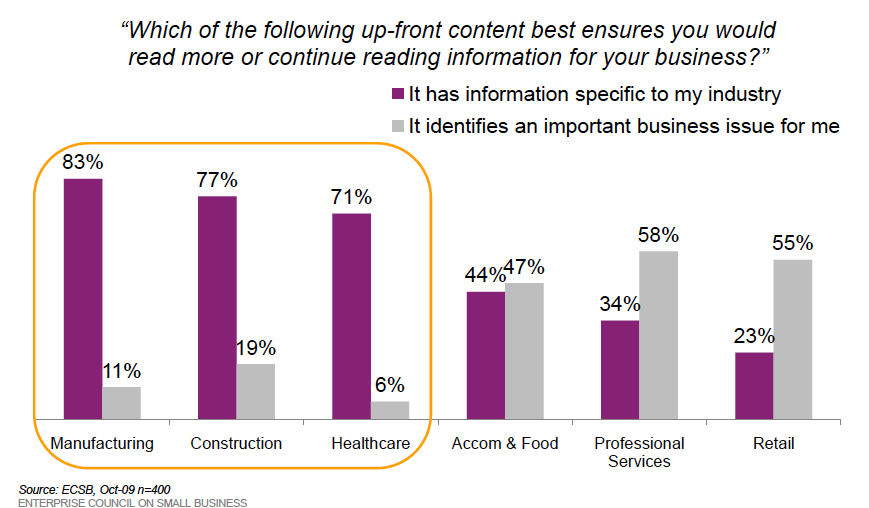
Business owners in healthcare, construction and manufacturing want information specific to their industries. Owners of professional services or retail want information specific to them.
Satisfaction owners are looking for products and services that save them time savings and strengthen their relationship with customers. With Growth Oriented owners talk ROI, and time to payback.
Summary – it’s OK to categorize your services or products as small business solutions, but don’t call the buyers small business owners. Recognize that there are two different types business owners focused on two different goals – lifestyle vs. growth. Both groups are interested in hearing your value proposition in terms of real dollars on a monthly basis, not over the year.
Business owners are heavy users of search for researching vendors, and they use social media to promote their business, but not for buying from vendors. To be relevant your content must speak to their industry or similar size businesses.
If you talk to them like you know them, show them you are committed to building a lasting relationship this dynamic market can power your organizations growth.


















